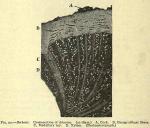163. Berberis Radix.—Barberry Root. 164. Berberis Cortex.—Barberry Bark.
 163. BERBERIS RADIX.—BARBERRY ROOT. The root of Ber'beris vulga'ris Linné. Habitat: Europe, Western Asia, and North America. Thick, much-branched, from 25 to 50 mm. (1 to 2 in.) in diameter in the thickest part; wood light yellowish, hard, tough, with a very thin bark (see Barberry Bark below); odor slightly aromatic; taste bitter. It contains five alkaloids, of which berberine is the most interesting. Used as a tonic in doses of 30 to 60 gr. (2 to 4 Gm.).
163. BERBERIS RADIX.—BARBERRY ROOT. The root of Ber'beris vulga'ris Linné. Habitat: Europe, Western Asia, and North America. Thick, much-branched, from 25 to 50 mm. (1 to 2 in.) in diameter in the thickest part; wood light yellowish, hard, tough, with a very thin bark (see Barberry Bark below); odor slightly aromatic; taste bitter. It contains five alkaloids, of which berberine is the most interesting. Used as a tonic in doses of 30 to 60 gr. (2 to 4 Gm.).
164. BERBERIS CORTEX—BARBERRY BARK. The bark of the above root, coming in long, thin pieces, exfoliating, or separating into thin layers; outer surface yellowish-gray; inner surface bright yellow. It contains the same alkaloids as the root, but in greater proportion. This species is the host plant for the common wheat rust (Puccinia graminis) in its accidio stage. The leaves when parasiticized by this fungus seem to be covered with yellow spots, the openings of the cups in which the spores are borne. Dose: 3 to 10 gr. (0.2 to 0.6 Gm.).

